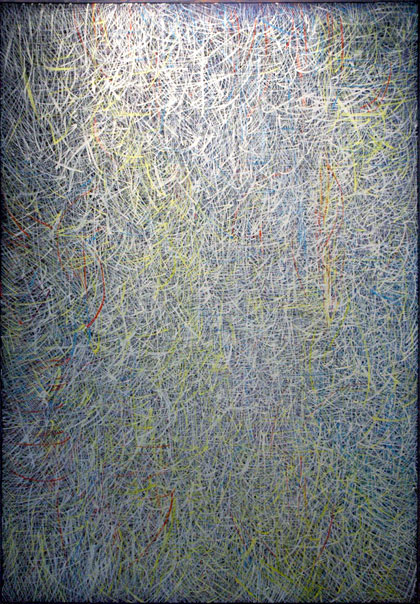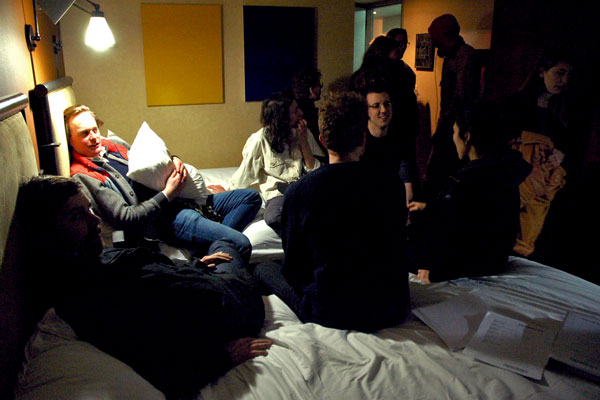
John Blee Jewel Return 1982 acrylic on canvas 48" x 33"
I met our friend John Blee soon after I had moved to New York in 1985. I knew him first as a brilliant mind and an engaging conversationalist. I quickly found out that he was a painter and was relieved, and delighted, to learn that I really liked his work. It might not be too much of a stretch to attribute much of my ensuing engagement with the New York art world to our friendship in the 80s. John moved to D.C. years ago, much to my sorrow, but we never lost touch.
At the time we first knew each other he shared an incredibly vast unfinished loft with several truly tonic friends in what was just beginning to be referred to as "DUMBO" It faced Manhattan, and its windows overlooking what I used to call the "electricity factory," where a transformer would occasionally act up, lighting the night sky. Of course it made me think of the paintings.
John is still in Washington, but he's having a show this weekend in DUMBO, in the gorgeous apartment (with incredible views) of Norma Jean Markus. It's a return of sorts to the neighborhood which gave birth to so many beautiful canvases, even if the neighborhood itself has changed dramatically. For one thing, a visitor from Manhattan will no longer be the only one on the street after the end of the day shift.
Event Details:
Reception: Sat., March 12, 4 - 7 pm and Sun., March 13, 1 - 4 pm
Location: 70 Washington Street #12G, DUMBO, Brooklyn
To visit by appointment: Contact Norma Jean Markus at 917.446.7234
As Barry writes on Bloggy, many visitors to our apartment have admired the two paintings we have of John's. The larger one was actually one of the first works of art I had bought for the apartment. In Brooklyn this weekend you can see a range of his work from the 1980s to the present.
Related blog post: Art Wrap.
Below is an essay by writer and art critic David Matlock on John's work.
John Blee in DUMBO
As the 100th anniversary of Kandinsky' s breakthrough approaches, it is fair to ask: what
has been achieved? Are abstract paintings today repeating what has already been said--
and with each repetition, fading in strength? Or do they have something new to say, both
from a technical standpoint and in terms of meaning?At the beginning, abstraction exploded. Kandinsky himself tried to consolidate a more
controlled language and connoisseurs still argue about his degree of success. When the
Abstract Expressionists adopted the language on a larger scale, canvases exploded again
in shamanic frenzy. Success was hit or miss, all too dependent on possession.John Blee' s first mature paintings, dating from the early 1970s, were also shamanic,
painted on the floor, and dependent on force and a possessed dancing. In a career of 40
years, the man has achieved total control over paint and, more importantly, now owns
his meditative inscape. He owns the land that earlier painters had to burst into by force.
His paintings are deliberate acts of self-intoxication. (It is worth noting, that although he
came of age in the 1960s, he has always disdained the use of recreational drugs.) The
Hindu and Buddhist art he experienced as a child and adolescent in India were formative;
as was the medieval sculpture in the caves of Ajanta and Ellora; and the work of Indian
modernists in the National Museum. Blee responds to Asian art as an insider--someone
who was shaped by the culture before he received his American inheritance.The paintings on display are easy to enjoy but difficult to understand. From a technical
standpoint, the rendering of space is unique. There is nothing arbitrary or " atmospheric"
about the backgrounds--they are architectonic--that is, they create a definite space in
which " painterly event" unfolds. It is easy to take pleasure in the paint--casual admirers
often remark, " What a painterly painter! What a colorist!" without suspecting the hidden
narrative. I strongly suspect the hieratic " Sphinx" (2009) is one of Blee' s dogs, posing
nobly on the grass--the humorous title a reference to the difficulty of knowing what the
animal is really thinking. These paintings are truthful because they begin from within
and encompass the outside world in an ecstatic veil of paint. Earlier abstract painters
discovered a new continent; John Blee is traveling inland and is providing a faithful
record of what he finds.John Blee studied with Helen Frankenthaler, Robert Moskowitz, and Robert Motherwell.
His paintings have been shown in Paris, Moscow, Boston, Washington DC, and New
York City (including the Andre Emmerich Gallery). His work is in the Museum of
Modern Art and the Los Angeles County Museum.
He currently living in Washington DC.- David Matlock
Reproducing the subtleties of a painting is always a challenge, one which can never be met fully, but I hope John won't be too unhappy with shot at this wonderful painting. I photographed it with an available (overhead) light while it was hanging on the wall of the Brooklyn apartment where it can be seen this weekend. It also appears here on the artist's own site, more evenly lit, but on a smaller scale.

